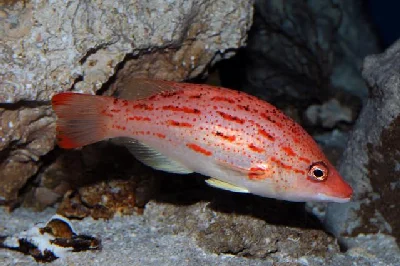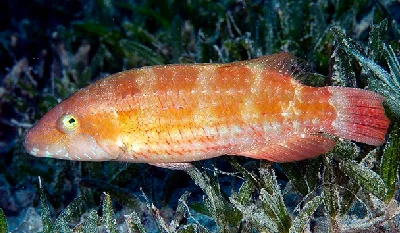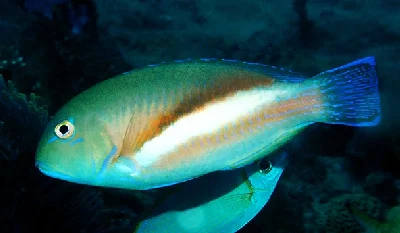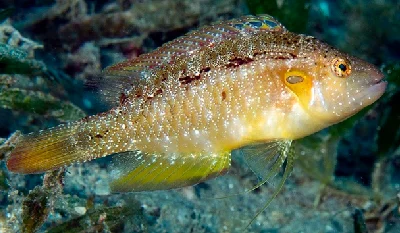Labridae
The wrasses, belonging to the family Labridae, are a diverse group of marine fish known for their vibrant colors. With over 600 species in 81 genera, they are divided into 9 subgroups or tribes. While most wrasses are small, measuring less than 20 cm (7.9 in), the largest, the humphead wrasse, can reach up to 2.5 m (8.2 ft) in length. These carnivorous fish have a varied diet, consuming a wide range of small invertebrates. They are known to follow the feeding paths of larger fish, taking advantage of the invertebrates disturbed by their movement.
Juvenile wrasses from certain genera, such as Bodianus, Epibulus, Cirrhilabrus, Oxycheilinus, and Paracheilinus, find shelter among the tentacles of free-living mushroom corals and Heliofungia actiniformis.
The term "wrasse" is derived from the Cornish word "wragh," a lenited form of "gwragh," which means an old wundefined or hag. This word is also related to the Welsh "gwrach" and Breton "gwrac'h."
Wrasses have distinctive mouths that can be extended forward, often with separate teeth that protrude outwards. Many species can be identified by their thick lips, which sometimes display interesting folds. This feature led to them being called "lip-fishes" in German and "lipvissen" in Dutch. The dorsal fin of wrasses typically consists of eight to 21 spines and six to 21 soft rays, stretching along most of their back. Wrasses exhibit sexual dimorphism, and many species have the ability to change sex. Initially, juveniles are a mix of males and females, known as initial-phase individuals. However, as they mature, the larger adults become territorial males, known as terminal-phase individuals.
Due to their unique jaw structures, wrasses have become a key focus in the study of fish-feeding biomechanics. These fish possess a specific configuration of bones in their nasal and mandibular regions, which allows for fast jaw protrusion or a forceful bite. This flexible structure enables varied jaw morphology among different lineages, achieving the same functional output and ecological niche.
Wrasses are predominantly found in tropical and subtropical waters of the Atlantic, 🇮🇳 Indian, and 🌊 Pacific Oceans, although some species also inhabit temperate waters. For instance, the Ballan wrasse can be found as far north as Norway. These fish prefer shallow-water habitats like coral reefs and rocky shores, where they dwell in close proximity to the substrate.
Most labrids, including wrasses, exhibit protogynous hermaphroditism in a haremic mating system. This reproductive behavior allows for complex mating systems to evolve. Labrids have been observed engaging in polygynous, lek-like, and promiscuous mating systems. Both group spawning and pair spawning occur within these systems, with the type of spawning depending on male body size. Labrids generally engage in broadcast spawning, releasing large numbers of planktonic eggs that are carried away by tidal currents. Adult labrids do not have any interaction with their offspring. However, wrasses from the Labrini subgroup of the Labridae family do not exhibit broadcast spawning.
Sex change in wrasses predominantly occurs from female to male, although experimental conditions have also allowed for male-to-female sex change. When two male Labroides dimidiatus wrasses are placed in the same tank, the smaller of the two will revert back to being female. Additionally, the largest female in certain situations may choose to remain female to maximize her evolutionary fitness instead of changing sex.
In the Western Atlantic coastal region of North America, the tautog, a species of wrasse, was once a common food source for indigenous humans. Today, wrasses are popular additions to both public and home aquariums. Some wrasse species are considered reef safe due to their small size. They are also utilized as cleaner fish to combat sea lice infestations in salmon farms. In fact, commercial fish farming of cleaner wrasses specifically for sea lice control in salmon farming has emerged in Scotland, showing promising commercial benefit and viability.































































